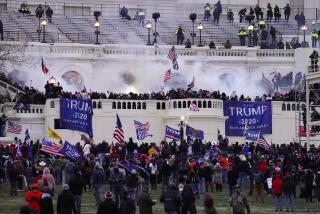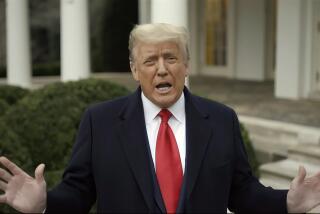Trump pleads not guilty to 4 felony charges in 2020 election case
- Share via
The former president pleaded not guilty in his first court appearance in the case related to efforts to overturn the 2020 election.
- Share via
WASHINGTON — Former President Trump pleaded not guilty Thursday to four federal felony charges in connection with accusations that he engaged in a multi-part conspiracy to overturn the will of voters and stay in power despite losing the 2020 election, resulting in an unprecedented attack on the U.S. Capitol.
Trump appeared before Magistrate Judge Moxila A. Upadhyaya at the E. Barrett Prettyman U.S. Courthouse in Washington, about a quarter-mile from where rioting supporters first attacked police officers and pushed down barriers on the west lawn of the Capitol on Jan. 6, 2021.
The judge took the bench just after 4 p.m. Eastern time, and the clerk called out: “Twenty-three dash 257, the United States of America vs. Donald J. Trump.” The former president shook his head when the criminal case name was read aloud.
“Good afternoon, Mr. Trump,” the judge said, moments after Trump’s attorney John Lauro introduced him as “President Trump.”
Upadhyaya informed Trump of the maximum sentences for each of the four counts: conspiracy to defraud the United States, conspiracy to obstruct an official proceeding, conspiracy against rights, and obstruction of or attempting to obstruct an official proceeding. The maximum sentences range from five to 20 years and each include up to $250,000 in fines.
Trump, who traveled from Bedminster, N.J., shortly before his court appearance, was flanked by his defense lawyers, Lauro and Todd Blanche. Besides providing his name and age and answering “yes” to questions about whether he understood the charges, the former president sat quietly, hands occasionally fidgeting, during the 27-minute arraignment in the cavernous Courtroom 22.
When asked for his plea, Trump stood to answer, pausing for emphasis between the words, “Not guilty.”

Justice Department special counsel Jack Smith sat in the first row of three benches that held reporters, staff and members of the public. Trump looked at Smith intently when the prosecutor first entered the room, and Smith glanced over at Trump during the proceeding, but the two men did not appear to make eye contact.
Trump’s next hearing is on Aug. 28 before District Judge Tanya S. Chutkan, who will preside over the trial. Upadhyaya relayed to the court that Chutkan intends to set a trial date at the hearing, which Trump does not have to attend. Prosecutors and the defense must submit filings before the hearing laying out potential dates for the trial and how long they expect it will take.
Lauro pushed for more details from the Justice Department about the scope of information they would receive before making that filing, saying that the defense needed “all that information, I think, to address when we will be ready.” But he was rebuffed by the judge, who said Trump’s lawyers needed to comply with the order from Chutkan.
Assistant U.S. Atty. Thomas Windom volunteered that the government is willing to turn over a large trove of evidence as part of the discovery process as soon as a protective order is in place.
“This case will benefit from normal order, including a speedy trial,” Windom said.
Lauro responded that it was “somewhat absurd” to think the trial can be done within the time frame of the Speedy Trial Act, which sets time limits for completing the various stages of a federal criminal prosecution.
“These are weighty issues; obviously the U.S. has had ... years to investigate the matter,” he said.
At the Justice Department’s request, the judge set a condition that Trump be barred from communicating with anyone known to be a witness in the case, except if his counsel is present.
Before the arraignment, Trump said to supporters on social media that he was on his way to the nation’s capital “TO BE ARRESTED FOR HAVING CHALLENGED A CORRUPT, RIGGED, & STOLEN ELECTION. IT IS A GREAT HONOR, BECAUSE I AM BEING ARRESTED FOR YOU.”
When he arrived at the courthouse, Trump did not have a mugshot taken.
Earlier Thursday, Metropolitan Police and Homeland Security officers outnumbered the dozens of reporters waiting to enter the courthouse or setting up cameras along the sidewalk. City dump trucks lined the street in front of the main entrance to the building, ready to block streets if needed.
The day before, the Capitol was under lockdown for hours after a 911 call suggested there was an active shooter in a Senate office building. Law enforcement cleared the area and later reported no such incident had occurred.
The indictment alleges that Trump pursued discounting legitimate votes and subverting the 2020 presidential election results through three criminal conspiracies.
By midday, about a dozen demonstrators had gathered outside the courthouse, and the crowd slowly grew.
One person waved a long pole with two large flags, one reading, “Finish the wall/Trump 24/Save America.” Another wore an inflatable costume of Trump in a diaper. By the end of the day, just a few protesters remained.
Trump has tried to cast the indictment and his other legal challenges as attempts to interfere with his 2024 presidential election campaign, complaining that he is being forced to spend time and money defending himself rather than campaigning.
“The Dems don’t want to run against me or they would not be doing this unprecedented weaponization of ‘Justice.’ BUT SOON, IN 2024, IT WILL BE OUR TURN,” he posted to Truth Social on Thursday morning.
Speaking to reporters at the airport before he left Washington on Thursday, Trump called it a “sad day for America,” echoing his earlier claims that the case against him is political.
“If you can’t beat him, you persecute him or you prosecute him,” he said.
The indictment alleges that after Trump lost the 2020 election, he and his allies concocted a variety of schemes to try to keep him in office, which included pressuring officials in several states to overturn their results on the basis of false claims of fraud.
Trump is also accused in the indictment of using the power of the Justice Department in an attempt to overturn the election by pushing the agency to “conduct sham election crime investigations” and to wield its authority to “falsely” buttress the legitimacy of his schemes.
The former president also solicited false slates of electoral votes from dozens of Trump-supporting electors in seven states, according to the indictment.
Douglas Frank has given dozens of speeches alleging voter fraud in California and across the country, and has helped create teams aimed at disrupting state election systems.
Trump is also alleged to have used false election fraud claims and the fake electoral slates to pressure then-Vice President Mike Pence to stop the Jan. 6, 2021, congressional certification of Joe Biden’s victory by either throwing out results for the Democrat in certain states or by delaying the official electoral vote count.
When Pence refused on the morning of Jan. 6 to comply, the indictment states, Trump took advantage of the violence at the Capitol “by redoubling efforts to levy false claims of election fraud and convince Members of Congress to further delay certification based on those claims.”
The former president was one of three defendants Thursday facing charges related to the Jan. 6 attack on the U.S. Capitol. The two others, a former Chicago police officer and a former voice actor on the television show “Bob’s Burgers,” are among the more than 1,000 people charged.
Seven federal district court judges filled the back row of the courtroom, including Chief Judge James Boasberg, Amy Berman Jackson and Randolph Moss. They have collectively heard hundreds of Jan. 6 cases and have several hundred more on their schedules. The cases could number in the thousands if the Justice Department makes all of the arrests it says it intends to.
Additional charges could be possible as Trump’s case progresses. The indictment refers to six unnamed co-conspirators with enough detail, such as dates of conversations, to provide strong indications as to their identities.
Smith said Tuesday that his team’s “investigation of other individuals continues.”
The new charges against Trump are just the latest developments in the legal peril the former president faces as he campaigns for the 2024 Republican presidential nomination.
In March, he is scheduled to stand trial in New York on allegations that shortly before the 2016 election he paid an adult film star through an intermediary so she would not disclose information about an alleged affair she had with Trump, and that he covered up the payment while in office.
In May, Trump is scheduled to face federal charges of willfully retaining classified government records after leaving office in 2020 and obstructing the investigation into the matter.
And more is expected. Fulton County, Ga., Dist. Atty. Fani Willis in Atlanta has said she will make a decision on an indictment by Sept. 1 following a lengthy investigation into Trump’s efforts to pressure state election officials to “find” the votes needed for him to reverse his loss in that key state in 2020.
More to Read
Get the L.A. Times Politics newsletter
Deeply reported insights into legislation, politics and policy from Sacramento, Washington and beyond. In your inbox twice per week.
You may occasionally receive promotional content from the Los Angeles Times.














